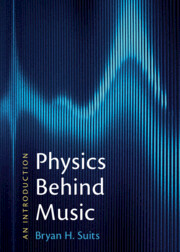Refine search
Actions for selected content:
8 results
13 - Artists’ Perspectives Experimental and Electronic Music in Australia
- from Part III - Diversities
-
-
- Book:
- The Cambridge Companion to Music in Australia
- Published online:
- 14 November 2024
- Print publication:
- 14 November 2024, pp 205-218
-
- Chapter
- Export citation
14 - Electronic Composition
- from Part III - Styles, Conventions, and Issues
-
-
- Book:
- The Cambridge Companion to Composition
- Published online:
- 25 May 2024
- Print publication:
- 30 May 2024, pp 217-232
-
- Chapter
- Export citation
19 - Djent and the Aesthetics of Post-Digital Metal
- from Part V - Modern Metal Genres
-
-
- Book:
- The Cambridge Companion to Metal Music
- Published online:
- 31 August 2023
- Print publication:
- 14 September 2023, pp 265-280
-
- Chapter
- Export citation

Physics Behind Music
- An Introduction
-
- Published online:
- 24 May 2023
- Print publication:
- 06 April 2023
-
- Textbook
- Export citation
20 - Technologies and the Serial Attitude
- from Part IV - Contexts II
-
-
- Book:
- The Cambridge Companion to Serialism
- Published online:
- 07 March 2023
- Print publication:
- 16 February 2023, pp 340-364
-
- Chapter
- Export citation
13 - Ash Ra Tempel, Manuel Göttsching, and Klaus Schulze
- from Part II - Music
-
-
- Book:
- The Cambridge Companion to Krautrock
- Published online:
- 20 October 2022
- Print publication:
- 27 October 2022, pp 201-217
-
- Chapter
- Export citation
18 - Krautrock and German Free Jazz, Kraut Fusion, and Detroit Techno
- from Part III - Legacy
-
-
- Book:
- The Cambridge Companion to Krautrock
- Published online:
- 20 October 2022
- Print publication:
- 27 October 2022, pp 278-292
-
- Chapter
- Export citation
5 - The Sound of Krautrock
- from Part I - Context
-
-
- Book:
- The Cambridge Companion to Krautrock
- Published online:
- 20 October 2022
- Print publication:
- 27 October 2022, pp 74-90
-
- Chapter
- Export citation
